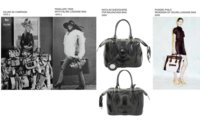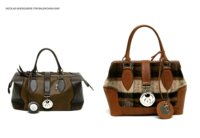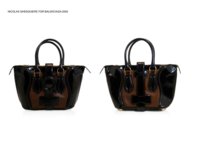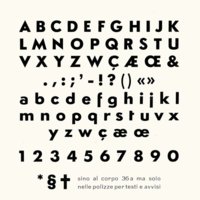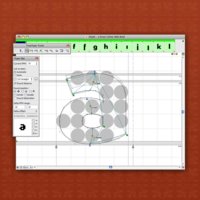www.nytimes.com
DESIGN
Peter Miles Applies His Quirky, Simple Style to a Range of Platforms
By ALICE RAWSTHORN
Published: December 20, 2009
NEW YORK — One letter complained about the shoddy state of a road. Another about a stagnant pond. A third accused a detective from Police Station Precinct 17 of stealing a ball. A fourth demanded that a neighbor’s radio be confiscated.
Céline
Peter Miles has designed the new packaging for Céline.
The potholed street, stinky pond, missing ball and blaring radio were the subjects of letters written by disgruntled New Yorkers to the city’s mayor between 1751 and 1969. The American artist, Matthew Bakkom, chose 132 of the thousands of letters in the municipal archive and worked with the graphic designer, Peter Miles, to turn them into a book, “New York City: Museum of Complaint.” Mr. Miles has designed lots of books before, but he also commissioned and edited this one, which is the first to be published by Steidl-Miles, the new imprint he has established with Steidl, the German art book publishers.
“I don’t think it gets better for a graphic designer than books — they’re just the best things to put together,” he said. “There are none of the constraints with Steidl that you have with other publishers. You can do pretty much whatever you want. We’re still figuring out Steidl-Miles as we go along but, for me it’s about not just working as a designer, but to be reading and interpreting work beyond how it is on the page.”
The first book in the series has all of the hallmarks of Mr. Miles’s designs. It sports a plain white cover enlivened only by a photograph of a shabby 1918 postcard addressed to “The mayor, City Hall. n.y.” on the front, and the title spelled out on the back in the spindly black lettering with seemingly awkward gaps between the words. “Peter’s work is very assured, and distinguished by its quirks: the odd use of type, the strange spacing and sizing,” observed a fellow graphic designer, Paul Neale of Graphic Thought Facility. “He always pitches it perfectly, never taking things too far.”
You can spot the same mix of simplicity and idiosyncrasy in the other projects produced by Mr. Miles, a 43-year-old Briton, in his studio on New York’s Lower East Side. Most of his work is for people with whom he has collaborated for years, including books for Steidl and the photographer Juergen Teller; film graphics for the director Sofia Coppola; and advertising campaigns for the fashion designer Marc Jacobs. Working together for so long has enabled them to define a visual language, and refine it.
“Peter has an editor’s sensibility, he pares things down and cleans them up,” said the design historian, Emily King. “The Marc Jacobs ads appear like neatly shaped instalments in a long-running, almost Dickensian tale. The presentation and framing are all about restraint, but the overall project is about anything but.”
If Mr. Miles had his way, his designs would be even cleaner. “I want to be less and less visible in my work,” he said. “My feeling is that graphic design should be reduced right down. I don’t want to be aware of it in any circumstances. I’m working on Sofia’s new film, ‘Somewhere,’ now, and the graphics are stripped right back, which is how I like it. I saw Michael Haneke’s film ‘The White Ribbon’ recently, and the titles look as though they were done in the crappiest Times Roman typeface on a PC. They look perfect.”
He wasn’t always quite so restrained. After leaving the Royal College of Art in 1991, he founded the design group Fuel in London with two college friends, Damon Murray and Stephen Sorrell. Fired by what he describes as “a healthy hatred for what we were doing,” Fuel championed an aggressively purist graphic style in a backlash against the theatricality of the 1980s. “The three of them worked together all day every day, all alone, no assistants, no secretary from the same room in Fournier Street,” recalled Ms. King, who likened Mr. Miles’s sudden departure for New York in 2004 to “a divorce.”
Mr. Murray and Mr. Sorrell stayed in Fournier Street, and have thrived. “What they do is great,” said Mr. Miles. “They’re still the most interesting designers out there. But I wanted another challenge, and to see if I could do it without the safety net of two partners. I thought I should give it some distance, so I moved to New York.”
Five years later, his English accent is unscathed, as is his devotion to the Arsenal soccer club. He arrived planning to work on Marc Jacobs’s campaigns and occasional projects for Steidl, Mr. Teller and Ms. Coppola. A few months later, he started a three-year assignment for the auction house, Phillips de Pury, and has since taken on The Journal, an indie art magazine based in Brooklyn.
Much of the last year has been devoted to designing a new identity for Céline, the French fashion label now being reinvented by a new creative director, Phoebe Philo. Mr. Miles has worked with Mr. Teller on the ad campaigns, and designed dozens of boxes, bags and other stuff needed by Céline and its 300 stores. The logo itself consists of the name in a digital font, inspired by a mid-20th-century Italian one found in an old type specimen book.
So far so simple, but then come the details. Céline appears in what Mr. Miles calls “a left in the sun black” on creamy white with splashes of dark red detailing. Rather than emboss the logo onto the packaging as other brands tend to, he has debossed — or carved — it into the surface, to create subtle shadows. Designing a font was new to him, as was working on such a big scale and navigating the corporate politics of Céline’s owner, the luxury giant, LVMH.
“The logistics take away from what you can do,” he said. “But I still feel I’ve managed to get something into it. It’s the sense I always try to find of making something that looks as though it should be right, but it isn’t, and you don’t know why.”
